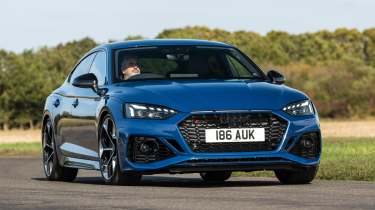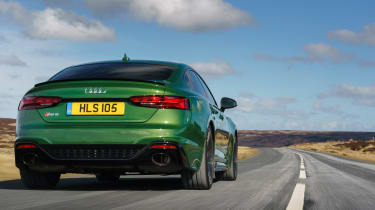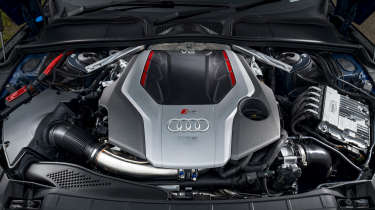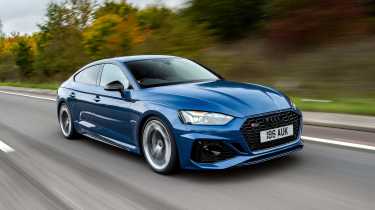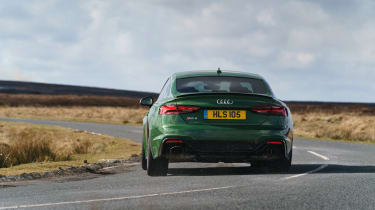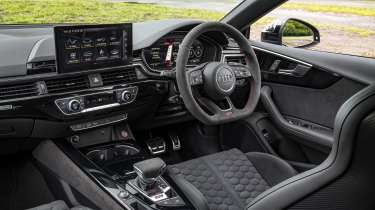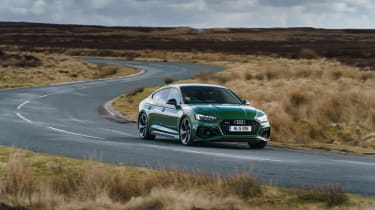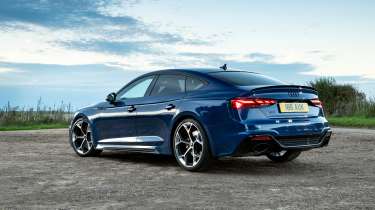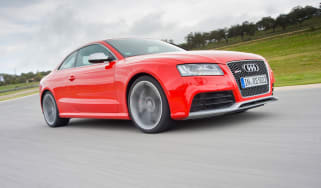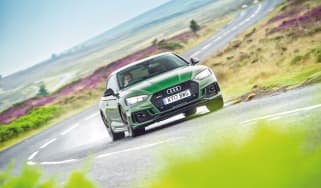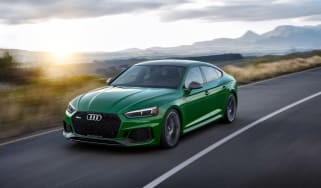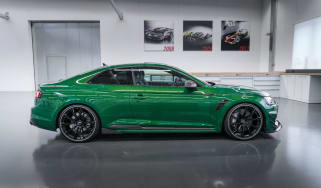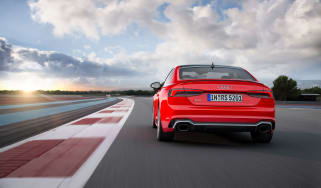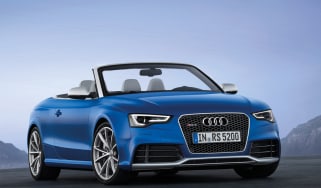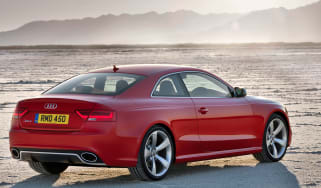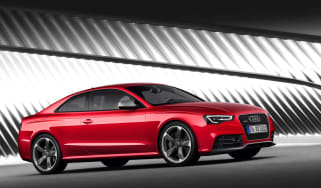Audi RS5 Sportback (2019 - 2024) review – the sensible BMW M3 alternative
The first Audi RS5 Sportback might lack the edge of Alfa’s Giulia QV, but its less frantic approach has strong appeal
It took a while for Audi to finally ask Audi Sport to add its RS ingredients to the A5 Sportback recipe to create the RS5 Sportback, which arrived in the early summer of 2019. Originally conceived as a peace offering to North American customers who don’t get the RS4 Avant, the RS5’s five-door hatchback body offers some of the Avant’s practicality in a sleeker style.
You’ll be pleased to hear it offers all of the über-wagon’s performance, too. Over its life it received a nip and tuck here and there and finally, a list of goodies familiar from the RS4 Competition to create the RS5 Performance, arguably the most intense, driver-focused RS5 yet made.
The updates for the 2020 car were purely cosmetic, featuring a nose job that sees the RS5’s single-frame grille now more closely resembling that of its big brother RS6 and RS7. Nineteen-inch wheels were standard, with three styles of 20-inch offered as an option. An RS5 Performance Edition is identifiable by its distinctive machined 20-inch wheels, more squat stance and carbon visual addenda.
Inside the RS5 can be dated by its MMI infotainment system, which got larger for the facelift. The driver mode controls gained a quick access RS mode button on the steering wheel for the facelift too. Highly distinctive in the RS5 Performance are the supportive carbon-backed bucket seats and suede trim throughout the cabin.
More reviews
In-depth reviews
Reviews
Equipped with identical running gear as the Coupe and Avant, the 2.9-litre, twin-turbo V6 RS5 Sportback is an intriguing proposition, one that has no direct rivals and could tempt one or two from their RS4 Avants
Engine, gearbox and 0-60mph time
It’s not the most charismatic of engines, despite Porsche's hand in its development, but the 2.9-litre, twin-turbo V6 installed between the RS5 Sportback’s swollen front arches (15mm wider) suits the nature of the car. Many will argue that its 444bhp and 442lb ft of torque mean it is found wanting against rivals from Italy and its home country, and in some respects they would be correct.
No matter the engine driving mode selected via Audi Dynamic Select or the new RS button on the steering wheel, it never feels or sounds like a true thoroughbred. The throttle response can be sharpened up by selecting Dynamic mode, but the moment of hesitation when you ask the turbos to spool up is still longer than you expect it to be and certainly off the pace compared to its six-cylinder rivals. It lacks the fury and thunder of AMG’s V8s, the solid punch of BMW M’s straight-six, and the snap and crackle of Alfa’s Ferrari-lite V6. A 0-62mph time of 3.9sec suggests it’s no slouch (hand over an additional £1500 and Audi will raise the top speed from 155mph to 174mph), but it’s slow to rev and only really comes alive when the rev counter lights up like a Christmas tree ahead of an upshift.
Talking of gearchanges, the eight-speed S-tronic gearbox is well matched to the engine’s power and torque delivery, with shifts improving noticeably the more aggression you dial it up via the driving modes. Sadly the gearshift paddles are still too small, and while they now feel much better than on the original they still don’t entice you to change gear manually. Although, this is nothing new among cars with similar set-ups.
The RS5 Performance has a bit of extra attitude and potency to fill the gap. You feel more inclined to explore the higher planes of the Performance’s, um, performance. Switch up to Dynamic, plant the throttle and the RS5 Performance steams up the road, the 2.9-litre twin-turbo V6 hitting hard above 3000rpm, parping with each gearshift.
In relative terms the numbers are still quite modest, though the Performance did get a boost to 464bhp. Even then it was closer to an M2 than an M4 – but there’s real energy and flexibility in its delivery. It’ll do 186mph flat out, and 62mph in 3.7sec – two tenths quicker than the base car.
Though an M4 is more ballistic at full noise the RS5 still feels relentless, and ruthlessly efficient in converting its power into forward momentum. You simply plant the throttle as soon as you spot your exit, and snap through the eight-speed auto ’box. Shifts are fast, but there’s no satisfaction to be had from clicking the underwhelming plastic paddles behind the wheel.
Technical Highlights
The RS5 features four-wheel drive, and Audi Sport’s quattro version at that, rather than the simpler Haldex system. It will send more torque to the rear axle than the front, but there’s no option to switch to rear-wheel drive and drift for the cameras.
Ceramic brakes are optional and Audi’s Drive Select allows you to modulate engine, gearbox and differential settings, while the damper control gives you the option to switch between different interpretations of stiffness.
The changes to the MMI infotainment system have resulted in a larger screen, with the former model’s rotary control ditched in favour of a 100 per cent touchscreen interface. As with all systems like this it makes for a clumsy, distracting and dangerous user experience, although it makes Audi’s virtual cockpit far more relevant and questions the need for the larger screen in the first place.
What’s it like to drive?
Approach the RS5 as a Giulia Quadrifoglio rival and you’ll be sorely disappointed. Not only does its engine lack the punch, panache and performance of the Alfa’s, but the RS5 clearly hasn’t had the same attention to detail applied to its chassis that the Italian has. The steering lacks sharpness, although in today’s world of hyper-alert racks it’s refreshing to have a set-up that’s more considered and linear in its action. It certainly helps the RS5 flow along a road.
The ferociousness of an AMG V8 is lacking too (for obvious reasons), which means there isn’t the punch out of corners and down straights that you expect from a car wearing these badges and swollen arches. In isolation it feels decently quick when you ask it to get on with it, but it doesn’t have that sternum-crushing punch of its rivals when you let it loose.
Then there is the chassis, which feels a little heavy-footed and one-dimensional. Its body is neatly controlled but there is little flowing back to you as you pick your line and commit. The chassis is competent rather than chatty and confidence inspiring, which doesn’t help mask the RS5’s portly 1720kg kerb weight – a figure that can ask just a little too much of the brakes if you find yourself on a road with more hairpins than fourth-gear sweepers.
A bit of a damp squib then? Compared to the aforementioned rivals, yes, but consider the RS5 Sportback as a junior GT car rather than a junior supersaloon and it comes into its own. Knock your approach back to 80 per cent, lighten your grip on its leash and settle into a rhythm that asks less of the chassis and allows the engine to deliver in its preferred mid-range operating window and the whole car strikes up a rapport with you.
You notice the added focus as soon as you get rolling in the RS5 Performance. At low speed the ride is firm and a little noisy, and you get the impression that it’s been set up to work best not around town, but at higher speeds and suspension loads. The supportive carbon-backed seats help plug you into the driving experience, too, while the suede-rimmed steering is calm in your hands, if lacking ultimate precision.
It’s when you carry speed into corners that you really start to appreciate the support and control from the coilovers, that are fundamental to its personality shift. Like those fitted to the RS4 Competition. They come with stiffer springs and drop the ride height by 10mm (or 20mm if you get the spanners out), with three way adjustable dampers and stiffer roll bars. Working with the upgraded suspension hardware are Pirelli P Zero Corsa tyres and a ‘quattro sport’ diff with a more rearward bias – particularly when Dynamic mode is selected.
There’s composure and precision to the way the body moves, which naturally dials up your confidence and commitment. So too the standard-fit carbon ceramic brakes, which have excellent power and progression. When you do push harder, though, you simply find yourself covering ground at a faster rate, rather than discovering a wide window of adjustability to play with.
Be in no doubt, though, the Performance’s extra grip and control make it more satisfying to drive quickly than the standard RS5, and it’s still usable day-to-day if you can live with the more connected ride. It comes in the more practical five-door Sportback bodystyle, and though the cabin doesn’t feel especially cutting edge nowadays, we like the fact it isn’t a total screen fest. Fit and finish is superb, the switchgear operates with tactile precision and though there are fewer pixels than you’ll find in a new M4, you still get a fully digital instrument panel and a crisp, easy-to-use central touch display.
Price, rivals and replacement
For the money you could quite rightly expect the RS5 Sportback to be more competitive against the obvious alternatives, but in ways, it didn't hacve clear-cut rivals at all. You could almost think of the RS5 Sportback as a cut-price AMG GT63 S.
Standard RS5 Sportbacks weren’t cheap, with a price tag of £67,505 back when the car was facelifted in 2020. That rose gradually over the years and the RS5 Performance of 2024, with its added goodies, was a sturdy £101,645. That said, of note about the RS5 Performance is what rarity you get for your money. Just ten examples came to the UK
Still, by comparison, Alfa’s brilliant Giulia Quadrifoglio will set you back just £79,495, while BMW’s M3 Competition saloon will now require £87,205 of your British pounds. For something more purposeful but still usable day-to-day, Porsche will sell you a base 992.2 Carrera for just under £100k, too.
The Audi RS5 will return in 2025, albeit as a saloon and an Avant estate and as a hybrid. It's expected to feature a version of this outgoing car's V6, albeit fettled for integration with a plug-in hybrid system, for well over 500bhp. It'll also likely be heavier than this RS5 and almost certainly, more expensive.
